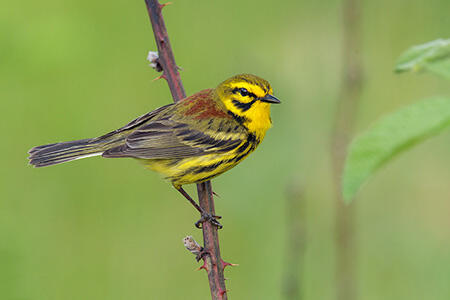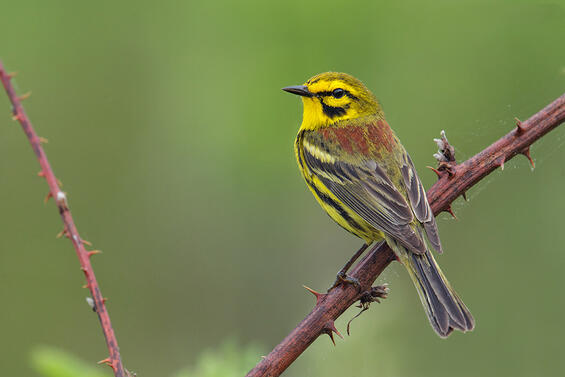- Scientific name: Dendroica discolor
Species of Greatest Conservation Need (MA State Wildlife Action Plan)
Description
The prairie warbler is a small songbird, 11 cm (4.3 in) in length. The male is overall bright greenish yellow with dark streaking on the flanks, dark lines on the face and a chestnut mark on the neck. The female is similar in color and pattern, but overall, much more subdued. The song is a buzzy series of notes that rise up the chromatic scale.

Prairie warbler
Life cycle and behavior
The prairie warbler is a neo-tropical migrant of shrubby oak woodlands, pitch pine barrens and areas of brushy secondary growth. Prairie warblers winter in low scrub throughout the West Indies and south Florida. They eat mostly insects and spiders but will also take mollusks and sometimes fruit. In Massachusetts, autumn migration begins in July, with birds returning to breeding grounds in late May.
Population status
Breeding Bird Survey data shows that the population of prairie warbler has experienced an overall decline of 2.0% from 1966 to 2002. Some of the most significant declines have occurred in the Ohio Hills region (4.5%) and in much of the species’ southwestern range. Declines in other areas have resulted in the species being listed as state-Endangered in Michigan, and the sub-species d. paludicola being listed as Special Concern in Florida. One region that has seen a significant increase to the population is northern New England (6.4%), although southern New England has decreased (3.1%), with Massachusetts populations declining by 1.06%.
The prairie warbler is considered a Tier I Conservation Priority by Partners in Flight and is listed as a Watch List Species by the National Audubon Society.
Distribution and abundance
The prairie warbler occurs in every county in Massachusetts, with a major population concentration in the scrub oak-pitch pine barrens of Plymouth County. Elsewhere it is uncommon to fairly common in areas of dry forests with secondary growth.

Prairie warbler
Habitat
The prairie warbler nests in areas of brushy second growth, dry scrub, low pine-juniper, pine barrens, and burned-over areas. The species is not sensitive to patch size and often is found breeding in dense shrub vegetation associated with regenerating clearcuts and power line rights-of-way.
In Massachusetts, the prairie warbler is commonly found on the southeastern coastal plain in scrub oak and pitch pine barrens, especially those that are periodically burned. Away from the coastal plain it is found in disturbed areas with heavy secondary growth, such as clearings beneath high-tension lines, overgrown pastures, and near brushy gravel pits.
Healthy habitats are vital for supporting native wildlife and plants. Explore habitats and learn about conservation and restoration in Massachusetts.
Threats
The major threat to prairie warbler populations in Massachusetts is loss of suitable habitat due to landscape conversion and succession. This species is also a frequent host to the brown-headed cowbird. Although shrubland birds as a group do not appear to be as sensitive to patch-size as other groups of birds, the indirect effects of suburban sprawl can be important through the magnified risks on ground nests from predation (domestic cats, raccoons, etc.) and cowbird parasitism.
Predation by domestic cats has been identified as the largest source of mortality for wild birds in the United States with the number of estimated mortalities exceeding 2 billion annually. Cats are especially a threat to those species that nest on or near the ground.
An additional threat to the species is collisions with buildings and other structures, as approximately 1 billion birds in the United States are estimated to die annually from building collisions. A high percentage of these collisions occur during the migratory periods when birds fly long distances between their wintering and breeding grounds. Light pollution exacerbates this threat for nocturnal migrants as it can disrupt their navigational capabilities and lure them into urban areas, increasing the risk of collisions or exhaustion from circling lit structures or areas.
Conservation
Restoration and management to maintain large tracts of dry shrubland habitat is the key to prairie warbler conservation in Massachusetts. This includes the conservation and restoration of barrens and oak woodland occurrences across the state, which ideally involves the use of prescribed fire. Managing utility rights-of-way has enormous potential for increasing habitat availability for shrubland birds and capitalizing on these already existing and essentially permanent shrublands should be encouraged whenever possible. Where suitable habitat currently exists, efforts should be made to protect the landscape from development.
Promote responsible pet ownership that supports wildlife and pet health by keeping cats indoors and encouraging others to follow guidelines found at fishwildlife.org.
Bird collision mortalities can be minimized by making glass more visible to birds. This includes using bird-safe glass in new construction and retrofitting existing glass (e.g., screens, window decals) to make it bird-friendly and reducing artificial lighting around buildings (e.g., Lights Out Programs, utilizing down shielding lights) that attract birds during their nocturnal migration.
References
Askins, R. R. 2000. Restoring North American Birds. Yale University, New Haven, Connecticut.
Petersen, W.R., and W.R. Meservey. 2003. Massachusetts Breeding Bird Atlas. Massachusetts Audubon Society and University of Massachusetts Press, Amherst, Massachusetts.
Sauer, J.R., J.E. Hines, and J. Fallon. 2004. The North American Breeding Bird Survey, Results and Analysis 1966 - 2003. Version 2004.1. USGS Patuxent Wildlife Research Center, Laurel, Maryland.
Veit, R., and W.R. Petersen. 1993. Birds of Massachusetts. Massachusetts Audubon Society, Lincoln, Massachusetts.
Contact
| Date published: | April 4, 2025 |
|---|